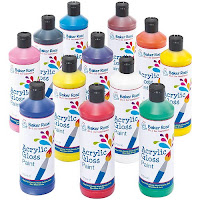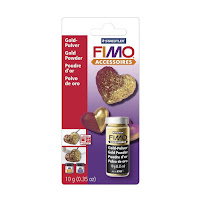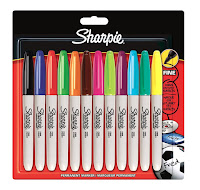Many clay products such as polymer and foam clay can be purchased pre-coloured. Stone based air dry clay’s are usually white, grey or terracotta. If you want to colour your clay there are two main techniques;
- Pre- cured - wet clay
- Post cured - dry clay
There are an abundance of pigments that can be used to add colour and shimmer to your creations. In addition to using tempura and acrylic paints, air dry clay can be coloured with marker pens, inks, chalks and dyes. Glitter glue and metallic powders can also be added for extra sparkle and great effects. Remember that air dry clay is porous and the finished creation should be sealed with a varnish.
Before adding a colourant to uncured clay knead the clay to soften it making it easier to accept the colour. Gradually add the colourant a small drop at a time, making sure you work it in fully before adding more. Continue adding a few drops at a time until you are satisfied with the shade. Colouring clay can be very messy so be sure to work over a surface that can be easily cleaned or thrown away, such as plastic sheeting or newspaper.
Acrylic, Oil and Poster Paints
Adding paint to clay before it is cured is one of the best options and most paints can be
 |
| Click for more paints |
When using paints post cured, make sure that the creation is completely dry before you start painting. With most air dry clays it is recommended that the piece is allowed to dry for at least 24 hours before painting.
Acrylic paint works well on most air dry clay’s especially stone based and cold porcelain clay. When mixing paints test the final colour on paper first but remember that the colour on clay may be slightly lighter on paper. Try and mix sufficient colour for you piece or make sure you record the exact quantities of each colour, in order to be able to recreate the same shade again.
 Use a variety of fine detailed good quality paint brushes to paint on the clay creations so as to ensure an even flow and detail. Nylon brushes work best with acrylic paints and natural (China) brushes for oil paints. Always make sure you clean you brush after each colour and never leave the brush upright in water, otherwise it will distort the brush tip.
Use a variety of fine detailed good quality paint brushes to paint on the clay creations so as to ensure an even flow and detail. Nylon brushes work best with acrylic paints and natural (China) brushes for oil paints. Always make sure you clean you brush after each colour and never leave the brush upright in water, otherwise it will distort the brush tip. Most paints will need two coats so be sure to allow the first coat to completely dry before adding the next coat. Protect the finished painted creation with at least two coats of good quality varnish.
Metallic and Glitter Powder
 |
| Click for Metallic Powder |
Permanent Pens, Alcohol inks and Marker pens
 |
| see more inks |
Washable marker pens are great to use with kids creative play as they are easier to clean but don’t work so well if you are trying to achieve a professional finish to your creation.
When mixing the colour try to ensure that hands are completely dry, it is also useful to have some baby wipes close by to easily clean your hands and prevent colour transfers.
Using pens on cured clay can also be really effective and often enable a lot more intricate
 |
| See more |
If you are using water based pens make sure that each colour dries first before touching the creation otherwise the colours may run. Don’t use water on your creation when using water based pens as this will also make the colours run.
It is also a good idea to experiment a little with marker pens and inks before using on your clay creations as some pens and inks may bleed when varnish is added because the colour is not completely dry.
Food Colouring
This type of method can be very messy although cake colourants can be purchased in gels and paste forms. Food colourants work best when mixed with uncured clay. They can also be used on cured clay although this will provide a stained effect rather than a smooth paint effect.
 |
| See more Fabric Dye |
Fabric Dyes
Useful Notes:
- If possible only colour enough uncured clay required for your project as some coloured clay, such as cold porcelain don’t store well and can turn mouldy.
- Try experimenting with different colourants and clay until satisfied with the outcome.
- Clean the surface of clay before painting to prevent airborne particles and dust settling and showing up on the paint finish.
- Make sure the finished painted creations are dust free before applying each coat of varnish.


No comments:
Post a Comment